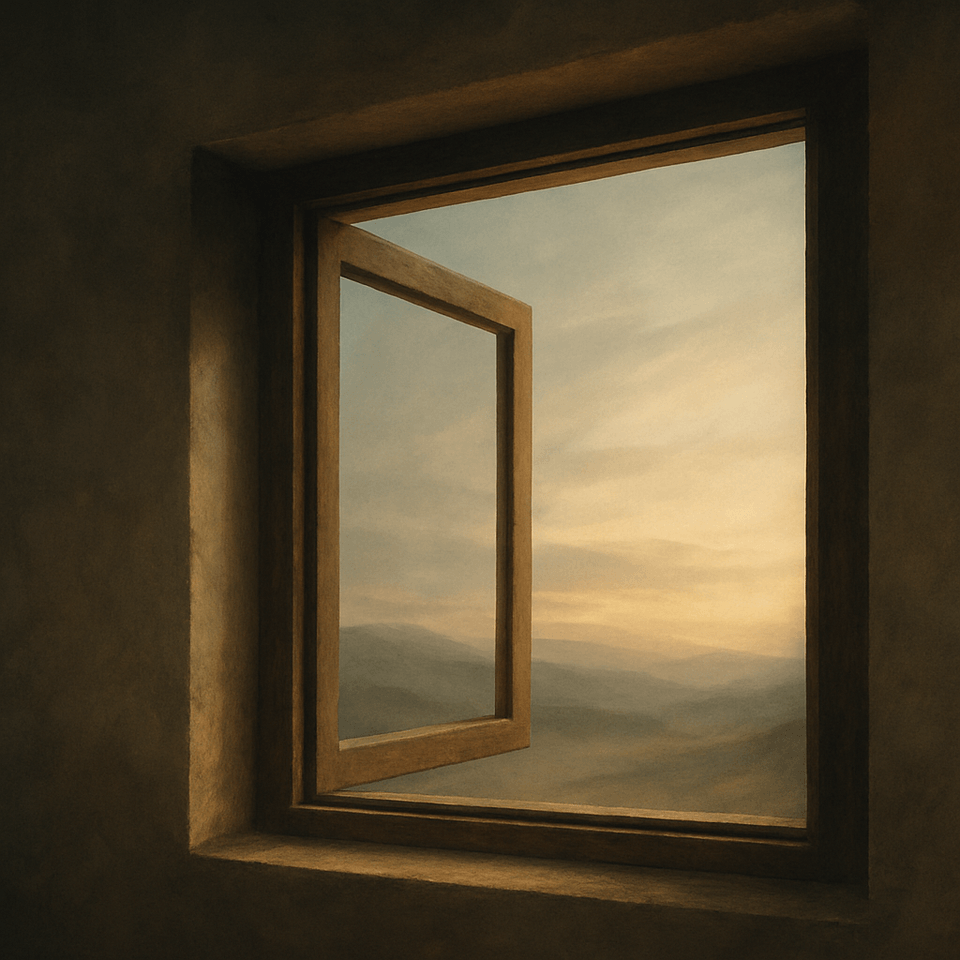
Considering the Shift of the Overton Window
The Overton Window is often described as the range of ideas deemed politically or socially acceptable at a given moment. But if we look more closely, it is less a static pane of glass and more a living frame—sliding, stretching, narrowing, expanding. The metaphor of the window reminds us that we are always looking through something. It is not the walls of a house. It is the breeze through an open room. It is the filter that shapes what we notice and what we ignore.
To speak of “considering the shift” is to pause and attend to this subtle architecture of perception. It is not only about the formal politics of legislation or policy; it is about the background atmosphere in which those things are even imaginable. Ideas are not born in a vacuum. They emerge within frames, and frames decide which ideas can stand in daylight and which must remain hidden in the shadows.
We might imagine the Overton Window as a kind of collective aperture. Too narrow, and our vision constricts. Too wide, and coherence dissolves. It is always in motion, adjusting to the pressures of culture, media, and history. What yesterday was shocking becomes today’s debate and tomorrow’s consensus. What yesterday seemed self-evident can, with surprising speed, become unspeakable.
This movement matters because it quietly defines the terrain of possibility. To live within a society is to live within a shifting grammar of the possible, the permissible, and the prohibited. The window is not just an abstract concept—it is the frame of our shared imagination. And by tracing its shifts, we begin to trace the shape of our own time.
Windows as Mirrors
The Overton Window is often framed as a tool of politics, a measure of what can and cannot be said in the public sphere. Yet if we linger with the metaphor, we find something more subtle: the window is not only a portal but a mirror. It reflects back to us not only the ideas we permit but the identities we assume.
A society cannot act on what it cannot imagine. If a possibility lies outside the window, it does not merely go unchosen—it often goes unseen. An idea outside the frame may exist in theory, but to the majority it feels absurd, dangerous, or impossible. Conversely, ideas within the frame carry an aura of obviousness. They seem natural, even inevitable. The window does not only delimit discourse; it shapes perception itself.
This reflective quality means that the window tells us more about ourselves than about the ideas it frames. A narrow window suggests a culture that feels threatened, defensive, easily destabilized. A wider window suggests confidence, resilience, or at least curiosity. In both cases, what the window reveals is not simply what a society thinks, but how it imagines its own capacity to change.
And so, to look at the Overton Window is to hold up a mirror. What we see in its reflection are the contours of collective self-image: what we fear, what we hope, what we are willing to risk, and what we are desperate to preserve. The window is not just about ideas—it is about identity.
The Mechanics of Movement
If the Overton Window is a frame, then its movement is not mechanical but organic. It rarely shifts through sudden decree or a single act of will. More often, the shift comes gradually—through the slow accumulation of gestures, metaphors, repetitions. It is less like an earthquake and more like erosion. A shoreline reshaped grain by grain, until one day the landscape is unrecognizable.
Consider how ideas enter the window. Rarely do they burst through with fanfare. They arrive first at the margins: in whispers, in art, in satire. A joke told often enough begins to soften resistance. A phrase repeated across headlines begins to feel familiar. A possibility sketched in fiction prepares the mind to accept it as fact. By the time the idea has stepped fully into the window, much of the groundwork has already been laid.
The same is true in reverse. Ideas also exit the window, sometimes without us noticing. What once seemed unquestionable can drift, slowly, into the realm of the unspeakable. The rituals that once organized a society become relics. The truths that once anchored a generation become curiosities for the next. The frame does not only invite new ideas in; it quietly pushes old ones out.
And always, the paradox: once the window has shifted, the new arrangement feels obvious. The impossibility of yesterday becomes the banality of today. We forget the resistance, the outrage, the insistence that “this can never change.” Retrospect paints the shift as inevitable. But inevitability is only the story we tell ourselves after the frame has already moved.
To trace the mechanics of movement, then, is to attend to the subtle engines of culture: repetition, narrative, metaphor, silence, and time. These are the levers by which perception shifts and the possible is remade.
Responsibility in the Frame
To notice the shifting window is to recognize that we are not just spectators. We are participants. None of us alone controls the frame, yet all of us lean against it in some way—nudging it forward, holding it still, or reinforcing its boundaries without realizing it. Every word spoken at a dinner table, every silence held in the face of controversy, every story shared or withheld contributes, however faintly, to the shape of the window.
The danger lies in passivity. When we treat the window as natural law—as though it were the weather, arriving and departing beyond our influence—we surrender responsibility for its direction. But the window is not the weather. It is scaffolding. It is built, maintained, and shifted by human hands. To believe otherwise is to confuse context with fate.
Responsibility, however, does not mean control. No single person can determine the horizon of the possible. Yet responsibility can mean discernment: asking what words we amplify, what metaphors we normalize, what ideas we allow to pass as harmless when they are in fact corrosive. To live consciously within the frame is to admit that even small gestures accumulate.
This is why responsibility in the frame is both ethical and imaginative. It asks: what kind of world are we quietly rehearsing through our conversations, our refusals, our entertainments, our daily rituals? The window is not merely shaped by politicians or pundits; it is shaped in classrooms, in kitchens, in jokes, in the stories we tell our children. To abdicate responsibility is to let the window drift wherever power or inertia take it. To embrace responsibility is to acknowledge that, however limited our reach, our lean against the frame matters.
Beyond the Window
For all its influence, the Overton Window is not the horizon itself. It is only a frame—temporary, provisional, contingent. Beyond it stretches a wider field of possibility, a terrain that remains invisible until the window shifts again. What lies outside today’s frame is not gone; it waits, sometimes patiently, sometimes restlessly, at the edges of imagination.
This is why every age feels both permanent and precarious. We are persuaded that the way things are is the way they must be. Yet history reveals otherwise: what one generation defended as sacred truth another can barely recall, and what one generation dismissed as absurd another may treat as common sense. The frame moves, and in moving, it humbles us.
To live with awareness of the window is therefore to practice humility. It is to resist the arrogance of believing that our current view is final. The truths we hold dear, the boundaries we treat as fixed, the impossibilities we dismiss without question—all of these may one day be reclassified. Today’s radical can become tomorrow’s orthodoxy. Today’s certainty can vanish into silence.
But humility is not the same as resignation. To recognize the window’s impermanence is not to surrender to cynicism, but to open ourselves to curiosity. What futures are we dismissing now because they lie beyond our frame? What possibilities—of justice, of flourishing, of human dignity—remain invisible because our window is too narrow to see them?
Beyond the window there is always a horizon. To consider the shift is to remember that our sight is partial, our context temporary, and our responsibility ongoing. The frame will move again, as it always has. The only question is how we attend to its movement—whether with fear, or with courage.
Standing with the Frame
The Overton Window will move—this is inevitable. The more pressing question is not whether it shifts, but how we stand with it as it does. Do we lean with fear, tightening the aperture to defend what is familiar? Do we lean with cynicism, dismissing every shift as manipulation or spectacle? Or do we lean with responsibility and curiosity, aware that the frame is provisional, but also aware that how we treat its edges matters?
To stand with the frame is to embrace paradox. We know that what feels permanent will pass, and yet we must still act as though our choices carry weight. We know that the horizon stretches beyond what we can currently see, and yet we must make decisions as though the present view matters deeply—because it does. The transience of the frame does not absolve us; it charges us with humility.
This stance is not a call to control the window—no one can. It is an invitation to attention. To notice the small ways in which repetition, metaphor, silence, and speech shift the contours of what is possible. To remember that the horizon beyond the frame is vast, and that our role is not to master it but to prepare ourselves for when the frame moves again.
The window will shift. It always has. What remains is the posture we bring to its movement. Fear or courage. Passivity or presence. Dismissal or discernment. To consider the shift of the Overton Window is, finally, to consider the kind of witnesses we choose to be—those who cling desperately to the old frame, or those who learn to stand with openness at the edge of change.


